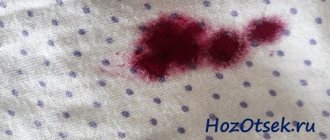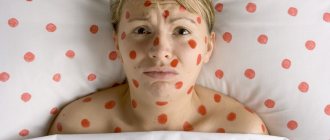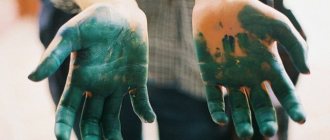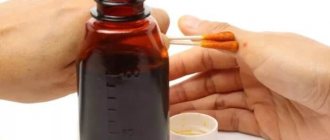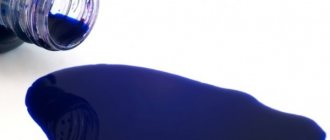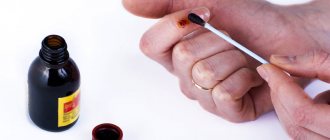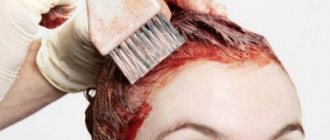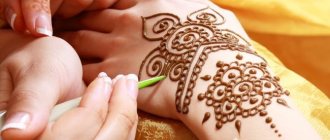Fucorcin stain is one of the most difficult to remove. If suddenly there is a need to remove such a stain from skin, clothing or furniture, then you will have to pay attention and time to this matter. After all, this substance is so persistent that it is used in graffiti markers so that the trace of it does not wash off. But, despite this, you can still wipe off “red green” stains at home. The most commonly used products are makeup remover, baking soda, vinegar and some household chemicals.
How to wash fucorcin from the skin (face, body, arms, legs)? (+video)
Cleaning the face of fucorcin should be done extremely carefully. It is necessary to use only the most gentle methods, since the skin of the face is very delicate. You don’t have to take any measures at all, because the skin cells die and are replaced by new ones, which means the product will be removed on its own in 1-3 days.
If you need to speed up the process, you can use the following recipes:
- Vegetable oil.
- Fat cream.
- Strong tea brew.
- Laundry soap.
- Vitamin C.
- Lemon juice.
Fukortsin does not need to be washed off the skin; it will disappear on its own within a few days due to the natural regeneration of the skin
For the skin of the body, arms and legs, you can use more “aggressive” methods, since the skin here is rougher and more resilient:
- soda;
- calendula;
- hydrogen peroxide;
- alcohol;
- makeup remover;
- aspirin;
- ammonia.
Vegetable oil
Soak a piece of cotton wool or a cotton pad in a small amount of vegetable oil and wipe the contaminated areas of the face with it. We change the cotton wool as it becomes dirty (it absorbs fucorcin). It’s even better to use sea buckthorn or olive oil, this will also moisturize your skin.
Fat cream
Apply any greasy cream to the stained areas, leave for 5-10 minutes, then wipe them off with a cotton pad or piece of cloth. We repeat the procedure 4-7 times, which is usually enough to remove such stains.
Strong tea brew
We brew strong tea, naturally black, and use it to treat the stained areas using a cotton pad or sponge. You can wipe your face skin in this way several times, as this is one of the most skin-friendly cleaning methods.
Laundry soap
We rub a bar of laundry soap on a medium-sized grater, then dilute the powder in water and end up with a concentrated solution. We moisten a cotton wool or a piece of gauze in it and wipe the contaminated areas with it 2-3 times.
Vitamin C
We take tablets or ready-made pharmaceutical powder, dissolve them in boiling water, and then cool. We moisten the gauze turunda in the prepared solution and wipe the marks on the skin with it. After treatment, be sure to wash the skin from any remaining product.
Lemon juice
We squeeze out fresh lemon or other citrus fruit (but lemon has the most powerful effect), after which we treat the contaminated areas of the skin with the juice, and at the end we wash off the remaining product. It is better not to use lemon juice in cases where there are minor abrasions or scratches on the skin.
Soda
Mix soda with warm water until a paste forms, which will then be used to wipe off traces of fucorcin from the skin. You can treat the skin with soda no more than 2 times, after which you must wash off the remaining product.
Calendula
Soak a cotton pad with calendula tincture and apply it to the stained area. Use the method carefully and without fanaticism, because calendula tincture dries the skin very much. A solution of calendula and soap has an even greater effect.
Add the tincture to the soap solution, soak a cotton pad in the solution and wipe the stains with it, then thoroughly wash off the remaining product. Please note: this modified method dries the skin even more.
Hydrogen peroxide
We soak a cotton pad or turunda in hydrogen peroxide, and then treat the areas of contamination. The advantage of peroxide is that it not only cleanses the skin, but also has an antimicrobial and antiseptic effect.
Alcohol
Apply a little ethyl alcohol to a cotton pad or turunda, then wipe the skin. Use only ethyl alcohol, no other.
Makeup remover
We use any non-aggressive cosmetic remover, moisten a cotton swab in it and wipe the stained area with it. Do not wipe the skin more often than once every 2 hours, otherwise contact dermatitis or local allergic reactions may develop.
Aspirin
Dilute 10 tablets of salicylic acid in warm water until you get a mushy mixture. Now apply the mixture with a sponge to the contaminated skin and wipe it. You can also apply a cotton pad soaked in the mixture to the stained area and hold for 5 minutes.
After treatment, be sure to wash off the remaining mixture and lubricate the skin with a softening or moisturizing cream.
Ammonia
We dilute ammonia with hydrogen peroxide in proportions of 1 to 3, wipe the stains with the solution and then thoroughly rinse everything with water. We use it no more often than once every 2 hours. Do not try to increase the concentration of ammonia - this will lead to skin burns.
Methods for sensitive baby skin
Children need to wash Fukortsin with milder means. The same methods can be used for adults if their skin reacts very sharply to external irritants.
Here are the main ones.
- Hydrogen peroxide (no more than 1.5%) and warm boiled water. Mix the components in equal proportions. Despite the fact that peroxide is a rather aggressive substance, its low concentration in the solution will not have any negative effect on the child’s skin.
- If peroxide is not found in the house, it can be replaced with Chlorhexidine. It is a little softer, but works just as effectively. Among other things, the antiseptic and bactericidal properties of Chlorhexidine will have an overall positive effect on the baby’s skin after treatment with Fukortsin. This applies most of all to skin that is affected by fungal and streptococcal infections.
- A highly concentrated solution of water and laundry soap. But you should first try it on a small area of the child’s skin to avoid excessive drying, because the procedure will have to be repeated at least 20 times a day.
How to wash off fucorcin from hair and teeth?
A special approach must be taken to cleanse hair and teeth, since standard methods will be ineffective or unsafe .
We clean our teeth like this:
- mix a tablespoon of baking soda with lemon juice (1/2 lemon), apply the resulting solution to a toothbrush and use it to clean plaque from the teeth;
- a method similar to the first recipe, but instead of lemon juice we use hydrogen peroxide - after brushing your teeth with this product, be sure to rinse your teeth to wash off the residue (soda has a negative effect on the enamel).
Hair should be cleansed in the following ways:
- lemon juice – squeeze the lemon and mix the juice with any hair shampoo, then wash your hair with the resulting solution and leave for 3 minutes, then rinse everything off with warm water;
- ammonia with olive oil - mix the components in proportions of 1 to 2, then treat the hair with the solution and immediately rinse everything off with warm water.
Composition of the drug
This medicinal solution contains boric acid, resorcinol, and acetone. The fucorcin solution received its bright color due to the presence of a component such as fuchsin in its composition. Because of its bright color, fucorcin is also called Castellani paint. Fuchsin, entering into a chemical reaction with acetone, gives the medicine a rich fuchsia color. Thanks to boric acid, the drug has disinfectant properties, while resorcinol gives it antiseptic qualities. In the network of modern pharmacies you can also find colorless fucorcin, which does not contain fuchsin. This drug will not cause problems with removing stains from the skin, but is less aggressive towards pathogenic fungal diseases.
How to wash fucorcin from clothes?
Removing stains from clothes is not difficult. To do this, you can use 2 methods:
- Bleach or any chlorine bleach. Based on them, we make a weakly concentrated solution, which we use to wash out the contaminated area. The solution can only be used on white or light-colored fabrics.
- Purchased stain removers. Used for colored products. It is very convenient to work with them, just follow the instructions (each product has its own instructions). After using the stain remover, you need to wash your clothes several times.
Special Recommendations
- Cotton pads, sponges, sticks, and soft facial brushes are useful as improvised means for washing stains.
- You won't be able to completely remove stains the first time. Any procedure will have to be repeated at least twice.
- Do not use solvents (gasoline, kerosene, acetone), as well as stain removers, bleaches or products containing chlorine as a component for the face and body. There is a risk of chemical burns, despite the effectiveness of these methods for removing crimson stains.
- An alternative to laundry soap is regular baby soap. It is somewhat softer in composition and will not dry out the skin as much.
- To cleanse children's skin, it is better not to overuse procedures. Just wait a few days and Fukortsin will wash off naturally.
You can wash off the medicine using any of the above methods only on completely healed areas. After cleansing, wash the skin with warm boiled water.
How to wash fukortsin from furniture?
It is even easier to clean furniture from fukortsin than clothes (problems can only arise with washing the sofa). The three most effective cleaning methods are:
- Soda ash or baking soda. Pour baking soda onto a damp cloth and wipe the stained area with it. We wipe from edge to center so as not to increase the area of stains and streaks.
- Soda with vodka or acetone. Mix the ingredients until you get a paste, which you apply to a cloth and wipe the dirty area with it.
- Salicylic acid. Soak a sponge in salicylic acid and wipe the contaminated area with it. Wait 5 minutes and wipe the area with a damp sponge. You need to remove the area treated with salicylic acid several times, then dry it with a hairdryer.
Features of the use of fucorcin
Initially, the main area of application of fucorcin was body marking in oncology. Doctors used it to mark those areas of the patient’s body that needed to be irradiated. Then fukortsin began to be used as a preoperative marking on the patient’s skin. Thanks to its bright crimson color and antiseptic properties, fucorcin coped with its tasks: it highlighted the incision site and killed microbes.
An alternative to fucorcin is brilliant green or iodine. They do not stain your hands even after drying, like fucorcin. But still, due to its medicinal properties, fucorcin solution is still used in medical practice. It better disinfects wound surfaces, copes with serious purulent skin diseases, and is used to prevent the spread of skin diseases. Fukortsin relieves itching and irritation, dries the skin and disinfects it.
How to wash fukortsin from carpet and other floor coverings?
You can remove stains from carpet and other floor coverings with a concentrated soap solution. To do this, rub a “brick” of laundry soap, dissolve the resulting shavings in water and add 2-3 drops of ammonia to the solution.
To clean furniture, you can also use aggressive agents, including soda, vinegar or alcohol solutions.
We wash the stains with the prepared solution, but do not wash it off immediately - wait 5 minutes until the solution is absorbed into the fabric. Then we wash the stains from the fabric with warm water, dry the product with dry towels, or, which is not recommended, lay it out on stools in a ventilated room and wait for “natural drying”.
Natural drying is not recommended because there is a chance of an unpleasant moldy odor appearing on the surface of the coating. Hanging drying is not recommended - this almost always leads to deformation and stretching of the fabric.
What products should not be used?
Not all products can be used to remove fucorcin. It is very important to wash it off without damaging the skin. Here's what we don't recommend using:
- gasoline, kerosene, and other flammable liquids;
- products with a high concentration of chlorine;
- undiluted ammonia or salicylic acid.
- Products containing alcohol are not suitable for sensitive, irritation-prone skin. They dry out the epidermis and cause itching.
After the fucorcin removal procedure, it is recommended to lubricate the skin with a soothing cream.
To protect your belongings and reduce the likelihood of accidentally spilling fucorcin to a minimum, you need to handle it with extreme caution: keep it in a place inaccessible to children and pets, treat the skin with a cotton swab or swab, and always carefully close the lid of the bottle.
